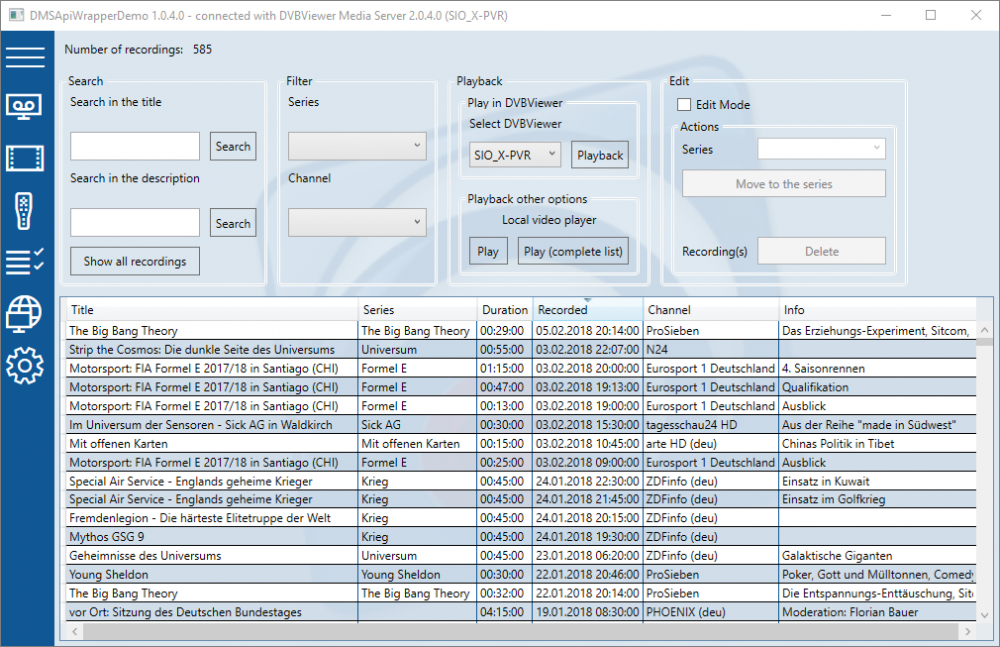Search the Community
Showing results for tags 'api'.
-
Der Output der API calls und die API Calls z.B. bei Timern hat sich über die Versionen geändert. Ich finde jetzt aber nicht die Change Logs um die aktuellste API nachzuvollziehen. Die API Seite scheint nicht auf dem aktuellsten Stand zu sein. ( https://en.DVBViewer.tv/wiki/Recording_Service_web_API#Timer_list) Lange Frage kurzer Sinn: Wo finde ich die Change Logs für den Media Server. Mein aktuelle Frage ist : Wie bekomme ich nur die Timer die enabled sind. Aber sicher gibt es auch andere Nettigkeiten. Danke im voraus.
-
I noticed several things during my tests that make debugging api calls difficult. /api/epg.html The returned XML string is often (but not always) incorrect if the EPG entry is not found. <?xml version="1.0" encoding="utf-8" ?><!-- by DVBViewer Media Server --><epg Ver="1"> The end tag is missing. Here it would be nice (besides the return of a valid XML string) to get an error code included. For example: wrong channelid, epgid not found When searching for pdc with a wrong pdc value (in my case 'NOPDC') this filter is completely ignored and the EPG list of the channel is returned. I think also here an error message would be more helpful. Many other api calls have no return value at all - e.g. timeredit. Here it would be helpful if the changed timer (or an error code in case of problems) would be returned.
-
Hallo zusammen, ich möchte für den DVBViewer und den Media Server plugins schreiben die (im ersten Schritt Daten im TS-Datenstrom abgreifen, später dann auch manipulieren) Gibt es irgendwo ein Projektbeispiel für Visual Studio in c++ oder c? Ich konnte leider keines finden, oder war nicht in der Lage einen passenden Suchbegriff zu formulieren. Grüße Thomas
-
Hallo, weiß jemand eine Möglichkeit wie man von FHEM aus EPG_Daten des Mediaservers aufrufen bzw. nach FHEM importieren kann? Also z.B. einmal am Tag für bestimmte Sender das Programm für z.B. die nächsten drei Tage. Ich weiß es gibt eine API-Schnittstelle im Mediaserver. Aber ich habe da keine Ahnung. Könnte man mit "http://[user]:[password]@[IP]:[port]/api/" Daten im Browser anzeigen lassen, die man dann mit Parsing abgreift? Wobei ich nicht einmal weiß, welchen User und Passwort ich in das Link eintragen müsste. Danke Michael
- 2 replies
-
- api
- mediaserver
-
(and 3 more)
Tagged with:
-
Hallo Griga, ich möchte ein meinem Programm neben dem CHANNEL-NAME auch die Quelle( SAT/Internet...HLS Deutsch....) einer Aufnahme anzeigen. In einem TIMER-RECORD habe kann ich hierfür den Node <CHANNEL ID> zerlegen und benutzen. In einem RECORDING-RECORD habe ich nur den Node >CHANNEL>xxxx</CHANNEL> Das reicht leider für meine Zwecke nicht aus. <recording id="98" charset="255" start="20181021195500" duration="001000"> <channel>Das Erste</channel> <channel ID>1234567890</channel ID> <file> d:\_aufnahmen\2018-10-21_19-59-23_das erste_tagesschau.ts </file> <title>Tagesschau</title> <image>2706243175_SM.jpg</image> </recording> Vielleicht kannst du diesen Node optional beim Aufruf hinzufügen: ....://localhost:8089/api/recordings.html?utf8=1&images=1;channel_id=1 vg & Dank Sir Drake
-
Hello Griga, maybe somthing for further versions. by using the Tasks-command ( api/tasks.html?action=.... ) i did not know, when a started process is finished. (also not if start has happen successfully. no feedback given ) should it be possible to implement this as a feedback once in the existing status2-request or in a sep. new tasks-status-request ? in a very specific case i need to know if a process has ended prior i fire the next command to dms. every suggestion is welcome brgds sir drake
-
Hallo zusammen, Dear english Reader, see below the german text. ich wollte euch gerne ein Projekt vorstellen, welches ich schon ewig vor hatte. Leider ist erst jetzt etwas daraus geworden. Im Prinzip geht es bei meinem Projekt darum, die Media Server API in die objektorientierte .Net Welt zu holen. Mein Projekt ist also ein Wrapper der nicht viel Wissen um die API mitbringen soll. Der Wrapper soll sich um alles selbst kümmern. Also um die Kommunikation mit dem Media Server und mit dem Aufbereiten der Daten. Was der Wrapper leisten soll: Der Wrapper soll es ermöglichen z.B. Massenänderungen an Aufnahmen vorzunehmen. Er soll es ferner ermöglichen leicht nach Inhalten zu suchen und diese auf dem Player seiner Wahl abzuspielen. Den Player selbst muss man entweder selbst erstellen oder man greift auf die integrierte DVBViewer Kontrollfunktionen zurück. Er soll auch eine komplette Ferndiagnose möglich machen. So denke ich darüber nach, den Wrapper auch nach .Net Core zu portieren, damit ich ein Überwachungstool des Servers auf einem Raspberry PI umsetzen kann. Auch ein Port nach UWP ist möglich, damit lassen sich Windows Store Apps umsetzen. Ich dachte mir nun: Wenn ich ihn weiter entwickele, dann darf er ruhig auf die Bedürfnisse anderer zugeschnitten werden. Den Sourcecode des Projektes habe ich auf Github online gestellt. Getestet wird der Wrapper von mir aktuell in einer CLI Anwendung. English Version: I wanted to introduce you to a project that I had planned for ages. Unfortunately, only now has something come of it. In principle, my project is about getting the Media Server API into the object-oriented .Net world. My project is a wrapper that does not have much knowledge about the API. The wrapper should take care of everything. So to the communication with the Media Server and the preparation of the data. What the wrapper should do: The wrapper should allow e.g. Make mass changes to recordings. He should also make it easy to search for content and play it on the player of his choice. You either have to create the player yourself or you can access the integrated DVBViewer control functions. He should also make a complete remote diagnosis possible. So I'm thinking about porting the wrapper to .Net Core so I can implement a server monitoring tool on a Raspberry PI. A port to UWP is possible, so that can be implemented Windows Store Apps. I thought to myself: If I continue to develop it, then it can be tailored to the needs of others. I put the source code of the project online on Github. The wrapper is currently being tested by me in a CLI application. German: Eine Demo CLI-Anwendung ist in der Beschreibung des Git. Sowie auch der Stand des Projektes. Um selbst damit zu starten, brauchst du nichts weiter über den MediaServer wissen, außer die IP-Adresse, den Benutzernamen und das Passwort. So hat man das Wichtigste mit den folgenden Zeilen Code schon erledigt. English: A demo CLI application is in the description of Git. As well as the state of the project. To start it yourself, you do not need to know anything about the MediaServer except the IP address, username and password. So you have already done the important thing with the following lines code. var dvbServ = new DVBViewerServerApi { IpAddress = "Name-of-PC or IpAddress", //Password is now a SecureString, read the readme on Github //Password = "password for guest or admin", User = "username for guest or admin", Port = 8089 }; German: Ich freue mich auf Reaktionen und Kommentare dazu. Hinzugekommen ist eine Demo-Applikation, welche in WPF geschrieben ist. Diese App funktioniert ab Windows 7. Einen Download findest du am Ende dieses Beitrages. Diese App unterstützt die Sprachen Deutsch und Englisch. English: I look forward to reactions and comments. Added is a demo application written in WPF. This app works from Windows 7. You will find a download at the end of this article. This app supports the languages German and English. Link zur Source: Projekt auf Github.com Link zur Demo mit grafischer Oberfläche - Sourcecode: Projekt auf Github.com Link zur Demo Release - Ausführbare Datei: Release auf Github.com
-
I try to write a javascript application to access the web api from Mediaserver (like Electron). Unlike other programming languages javascript restricts the requests to cross origin web services. Only if cross origin calls are allowed from the website they are done from the javascript engine.. The Webservice can allow this access by send a header entry like 'Access-Control-Allow-Origin', '*''. Today I get around with a small proxy server who adds this header to every requests - which is fine in development stage but not really fine for deployment. I havn't really understand what kind of Access Control is possible but I think for a local server like the DVB MediaServer to allow every access is ok because it is also possible with every other programming language. see also https://developer.mozilla.org/en-US/docs/Web/HTTP/Access_control_CORS I have attached my mini python server and a html page for testing. Please use firefox or chrome. The steps are : Install python3 if not already on your machine, edit pyproxy.py and dvbtest.html with the correct address of the media server (my media server is on 192.168.0.108) and start it with python pyproxy.py Afterwards you can open the html file dvbtest.html with firefox or chrome - Edge didn't work. I think I must provide for Edge something to the request to make a cross origin call. The html files a correct result from the pyproxy.py and no result from the original server. test.zip
- 2 replies
-
- api
- feature request
-
(and 1 more)
Tagged with:
-
I am not sure how to get the (optional) pdc value for the add timer call ( /api/timeradd.html ) When I do a request like this http://192.168.0.108:8089/api/epg.html?lvl=2&channel=562954320954462&start=42879.0&end=42880.0 I got (between a lot other entries) this entry for "The Mentalist": <programme start="20170524135600" stop="20170524145100" channel="562954320954462"><eventid>32133</eventid><charset>255</charset><titles><title>The Mentalist</title></titles><events><event>Blume im Meer, Crime-Serie, USA 2011</event></events><descriptions><description>In ...(cutted) </description></descriptions></programme> I can't identify a pdc value (what ever this is). How do I link the timer to this EPG? Even the timer entry (was created from an auto timer) shows nothing helpful regarding "pdc". <Timer Type="1" ID="{B7F254DD-72CD-4B5C-AFF9-641B23B199B3}" Enabled="-1" Priority="60" Charset="255" Date="24.05.2017" Start="13:46:00" Dur="75" End="15:01:00" PreEPG="10" PostEPG="10" Action="0" EPGEventID="32133"> <Descr>The Mentalist - Blume im Meer, Crime-Serie, USA 2011</Descr> <Options AdjustPAT="-1" AllAudio="-1"/> <Format>2</Format> <Folder>D:\Recorded_TV</Folder> <NameScheme>%name_%year-%date_%time_%station</NameScheme> <Source>Search:TheMentalist</Source> <Channel ID="2359890960395027550|kabel eins"/> <Executeable>-1</Executeable> <Recording>0</Recording> <ID>23</ID> <GUID>{B7F254DD-72CD-4B5C-AFF9-641B23B199B3}</GUID> </Timer>
- 5 replies
-
- media server
- timer
-
(and 1 more)
Tagged with:
-
Media Server, Add a timer, response, Feature request
DetlefM posted a topic in Scripting Lounge / API (de/en)
When I create a timer with http://192.168.0.108:8089/api/timeradd.html?enable=1&ch=2359890582721931325&title=MyTestTime&dor=42875&start=1150&stop=1205 all works fine but I get no response from the server. I think it will be fine to get an answer. A failure answer when something is wrong and maybe a timer record if all works fine. Because when I want to store this timer id where ever it is not easily possible. The only way I see at this moment is to create the timer with an UUID title, request a timer list after the creation call, remember the timer id and make a third call to change the title to something useful. And 1 call is better then 3 calls. And - not so important but helpful is to get api responses in json. Most of javascript and REST apis expecting the json format and somebody must convert it. And I prefer the server do it.-
- media server
- timer
-
(and 2 more)
Tagged with:
-
Is the page http://en.DVBViewer.tv/wiki/Recording_Service_web_API the actual version? It seems the changes I have seen at Media Server 2.x API Changes are not reflected there. I am playing around with the api and have some questions but I will open new topics for this questions.
-
- media server
- api
-
(and 1 more)
Tagged with:
-
"Fremde" Aufnahmen dem Recording Servide Hinzufügen
JanHB posted a topic in Scripting Lounge / API (de/en)
Hallo, gibt es eine Möglichkeit dem REcording Service Aufnahmen "unterzuschieben"? Hintergrund: Ich nutze den Recording Service, als Viewer kommt Kodi zum Einsatz. Immer mal wieder lade ich mir eine Aufnahme per Mediathekview runter. Jetzt würde ich dieses "Aufnahme" gerne unter Aufnahme in Kodi finden.-
- kodi
- recording service
-
(and 1 more)
Tagged with:
-
Hallo zusammen, ich habe einen neuen(?) Effekt im Recording Service entdeckt: Ich programmiere über die API 2 Timer für den gleichen Sender: Test1, RTL Nitro, heute, 19:15 – 19:45 http://localhost:8089/api/timeradd.html?ch=1083322141&dor=42116&enable=1&start=1155&stop=1185&title=Test1&format=1 Test2, RTL Nitro, heute, 19:16 – 19:44 http://localhost:8089/api/timeradd.html?ch=1083322141&dor=42116&enable=1&start=1156&stop=1184&title=Test2&format=1 Test2 ist vollständig in Test1 enthalten. Wenn ich die Programmierung in dieser Reihenfolge vornehme, wird lediglich Test1 programmiert. Die Eingabe von Test2 führt zu keinem Fehler, aber auch zu keinem Timer. Programmiere ich zuerst Test2 und dann Test1 erscheinen beide Timer. Programmiere ich direkt in der Weboberfläche (nicht über API) kann ich zuerst Test1 und dann Test2 erfolgreich anlegen. Woran liegt dieses Verhalten? Warum unterscheidet es sich zwischen API und Web? Ich verwende die Service Version 1.30.1.0. In der Version 1.7.2 trat der Effekt nicht auf, beide Timer werden in beiden Konstellationen angelegt. Über Hilfe / Tipps würde ich mich sehr freuen. Viele Grüße Marc
-
Hallo gibt es eine Möglichkeit einen oder alle FFMPEG-Prozesse per Api zu beenden? Ich arbeite gerade an einer Windows-Phone APP. Streamen funktioniert schon ganz gut, leider werden die Livestreams (trotz close() dispose() usw.) wohl nicht richtig geschlossen (erst nach beenden der APP), weswegen ich nach einer Möglichkeit suche die FFMpeg Prozesse per Api abzuschießen. Ich glaube, das ging mal mit dem Iphone Webinterface, leider finde ich nicht mehr raus wie. Falls es nicht (mehr) geht, wäre es wirklich super, wenn das mit eingebaut werden könnte. Vielen Dank und viele Grüße, Karl
-
Ich fände es sehr nützlich wenn man die API des Recording Service so erweitern könnte dass man auch direkt EPG-Daten im XMLTV-Format abrufen könnte. Das würde den Austausch mit anderen Tools sehr vereinfachen. Alternativ könnte man die Daten auch templatebasiert auch noch in anderen Varianten verfügbar machen. Oder gibt es schon andere Wege an die Rohdaten heranzukommen um sie mit weniger Aufwand konvertieren zu können?
-
Recording Service API - Timer löschen, Server Antwort
Mojo posted a topic in DVBViewer Recording Service 1.x
Hallo, im Moment lösche ich Timer über die Recording Service API (http://[user:password@]IP[:port]/api/timerdelete.html?id=xxxx). Um den Löschvorgang zu validieren, verwende ich die Server Antwort (HTTP/1.1 200 OK). Jetzt ist mir bei einem Fehler meinerseits aufgefallen, dass der Server diese Antwort auch bei einer ID liefert, die es gar nicht gegeben hat. Hat das einen Sinn oder ist das ein Fehler des Recording Services? Wie kann ich sonst überprüfen, dass der Timer gelöscht wurde? Einen Vergleich der alten Timer ID, EPGEventID, GUID mit den Daten aus einem erneuten Aufruf der Timerlist halte ich für recht umständlich. Viele Grüße Mojo-
- recording service
- api
-
(and 3 more)
Tagged with:
-
API - timers list contains invalid characters (according to Visual Stu
uglyned posted a topic in DVBViewer Recording Service 1.x
Hi, Having a go at reading in the timer list using the new async processes in Visual Studio 2012. The application throws an exception when reading in the timer list direct into a string, stating the following (I'm using the ?utf8 parameter in the query string). 'The character set provided in ContentType is invalid. Cannot read content as string using an invalid character set' However, if I read it into a byte array, then use UTF8 encoding to convert it to string, it works OK. So no big issue - there's an easy workaround, just thought you might like to know.



